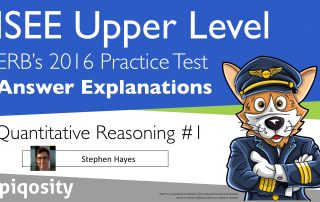About the ISEE Upper Level
 The ISEE Upper Level is the ACT of private school admissions for grades 9 through 12. Just as colleges use the SAT and ACT to determine applicant preparedness, many independent schools across the US achieve the same effect with the ISEE.
The ISEE Upper Level is the ACT of private school admissions for grades 9 through 12. Just as colleges use the SAT and ACT to determine applicant preparedness, many independent schools across the US achieve the same effect with the ISEE.
Because teachers, curriculums, and academic difficulty vary from school to school, a student’s report card is not sufficient enough to accurately compare students from different schools. Therefore they use a standardized test like the ISEE.
ISEE is an acronym that stands for the Independent School Entrance Exam. It is administered by the non-profit group ERB, Educational Records Bureau. You’ve probably heard of ERB before in the context of annual testing, particularly if your school administers the CTP-4, which is somewhat similar to the ISEE.
ISEE Upper Level Research, Analysis, & Adice
ISEE is One Test for Multiple Grades
While there are different variations of each ISEE test, it is very possible that a student applying to 9th grade could be taking the exact same test with the exact same questions as a student applying to 12th grade; however, we explain below how this possibility has negligible impact on the test's overall difficulty. The ISEE or Independent School Entrance Exam is offered in multiple levels including the Upper, Middle, [...]
ISEE Upper Level Official Practice Test Answer Explanations
The ISEE Upper Level is the private schools admissions test for students applying to grades 9 through 12. It is administered by the non-profit group, Educational Records Bureau, ERB, which is also the same group behind other popular private school tests like the CTP-4 often generically called "ERBs." An acronym for Independent School Entrance Exam, the ISEE is a 5-part, 3-hour standardized test: Verbal Reasoning, 20 minutes for 40 questions Quantitative [...]
ISEE Upper Level Practice Test Mathematics Achievement Video Explanations
Did you download the free ISEE Upper Level practice test, "What to Expect on theISEE Upper Level" from the ERB's website only to realize that there were no answer explanations? We have solved your problem (no pun intended) by creating video explanations for the the Mathematics Achievement section, which is what most students consider the second most difficult portion of the ISEE. Working with master tutor Stephen Hayes, we've created 42 videos to [...]
ISEE Upper Level Practice Test Video Explanations for Quantitative Reasoning
The Educational Records Bureau (ERB) makes only one near full-length practice test available for the ISEE Upper Level. Available as a free PDF download on its website, this is the only official practice test. However there at least two major downsides to this test. First, it is only 140 questions in length whereas the actual test contains 160 questions. The disparity is a result of the practice test omitting [...]
ISEE Math Review – Mathematic Properties
Math is filled with theorems, axioms, and properties. Though the following properties may seem simplistic, the ISEE will couple these properties with difficult concepts, such as algebraic functions. Reflexive Property A value is equal to itself. x = x Examples 17 = 17 y = 400 Symmetric Property Equal values may be placed on either side of the equals sign. x = y y = x Examples x = 25 [...]
ISEE Math Review – Order of Operations
Operations are the actions taken to solve math problems: addition, subtraction, multiplication, division, grouping (placing values in parentheses), and exponentiation (multiplying the same number to itself a certain number of times). Order of Operations was developed to make sure operations in a problem are completed in a particular order to achieve the correct result. The Order of Operations (PEMDAS) Parentheses Exponents Multiplication Division Addition Subtraction Multiplication does not outrank Division, [...]








